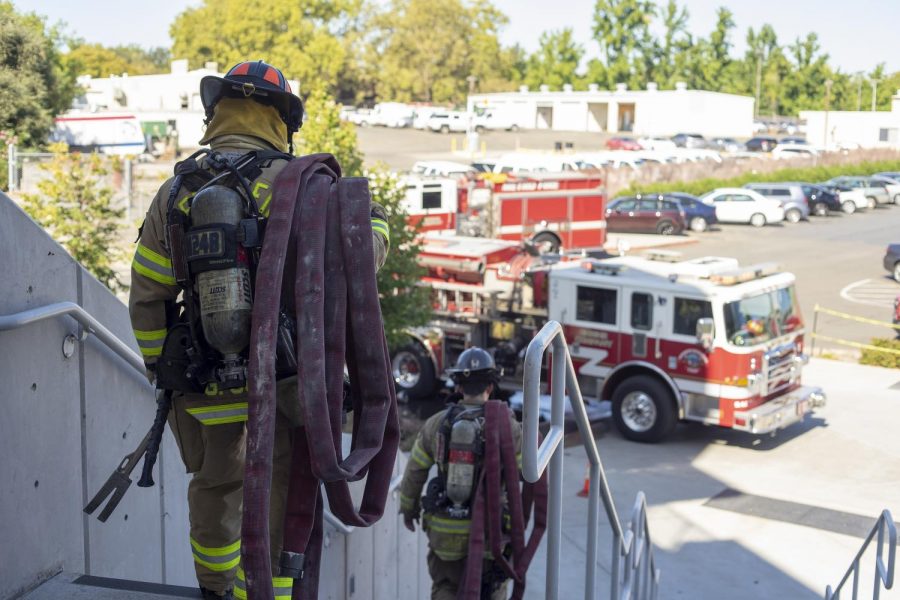Newsom signs legislation allowing incarcerated firefighters to become professionals upon release
How ‘megafires’ and a global pandemic led to criminal justice reform
California sees a decline in firefighters as many incarcerated firefighters in the Conservation Camp Program (CCP) have been released due to prison overcrowding and the fear of outbreaks of the COVID-19 virus within prisons. Upon release, these people were not eligible for professional employment as firefighters. Gov. Gavin Newsome decided to change this reality by signing AB-2147 which allows incarcerated firefighters to become professionals upon release. (File photo)
“I remember intense heat and smoke, exploding trees and the eerie orange glow at night sleeping in the hose bed of the fire engine,” Byron Gustafson said as he recalled his career in firefighting.
Gustafson is the dean of the Sacramento Regional Public Safety Training Center at American River College McClellan, and according to him, this is a typical day for a firefighter on the frontlines of a wildfire.
According to Cal Fire’s website, there have been 8,320 fires this year to date, with 4,040,935 acres burned across all of California.
Many of the people fighting these fires are working under the California Conservation Camp Program, which gives incarcerated people a chance to work and earn money while serving their time. However, until recently these individuals were extremely unlikely to find work fighting fires after they got out of prison.
On Sept. 11, Gov. Gavin Newsom signed AB 2147, which allows incarcerated firefighters, who meet the minimum eligibility criteria as determined by the Department of Corrections and Rehabilitation, working under the CCP, to become professional firefighters upon their release.
This effectively bars people from being discriminated against due to their felon status, but is on the job training with no degree enough to deem someone a professional firefighter?
Newsome thinks so, and Gustafson says he does too. Gustafson started his career in the field and says he has fought many fires, including both structure fires and wildland fires. Overtime he obtained a doctorate in fire science while working full time.
“Going through a focused and comprehensive academic program at a college is an excellent way to get the best career preparation, but it’s not the only way,” Gustafson said.
According to AB 2147, California has roughly 3,700 incarcerated people working at conservation camps under the CCP with roughly 2,600 of those being “fire line-qualified”. AB-2147 also states several counties across California use labor from county jail hand crews to help with fuel reduction programs as well as responding to emergency situations such as flood recovery or assisting firefighters to contain fires.
“The California Department of Corrections and Rehabilitation operates 44 Conservation Camps in partnership with the Department of Forestry and Fire Protection (CAL-FIRE) in 27 counties across California,” section one of the bill states. “In 2017, 650 incarcerated individuals assisted in suppressing the Pocket, Tubbs, and Atlas Fires. In 2018, close to 800 incarcerated individuals assisted with the Camp Fire in Butte County. Recently, over 400 incarcerated individuals helped battle the Kincade Fire.”
According to Gustafson, it’s actually quite common for firefighters not to have degrees and to, instead, have obtained experience from on the job training, regardless of their incarceration status.
“Many firefighters don’t have an academic degree,” Gustafson said. “There is a lot of important information that is conveyed through on-the-job training or training courses that may not be affiliated with a college.”
According to Gustafson, the ARC curriculum gives fire technology students an understanding of how fires burn, what techniques and equipment to use to put fires out, the differences in building design in regard to structure fires, systems and organization of people and processes as well as safety techniques, but he believes these things can be learned outside of a traditional college setting.
“There are different paths to gain the needed information,” Gustafson said. “This is what has historically been called Career Technical Education (or Workforce Education) in the academic world and it’s a kind of academic study that is directly related to employment preparation and job readiness.”
Gustafson said he thinks that on-the-job training or CTE should be thought of as an apprenticeship.
“So in the same way that some people become great chefs by working in restaurants and learning from senior chefs, some firefighters gain skills working in a fire department and learning from senior firefighters,” Gustafson said. “It’s basically the way apprenticeship works.”
AB-2147 came during a time when the need for firefighters has never been greater. The bill recognizes the same things that Gustafson said about on-the-job training.
“After receiving valuable training and placing themselves in danger assisting firefighters to defend the life and property of Californians, incarcerated individual hand crew members face difficulty and obstacles in achieving employment due to their past criminal record. Due to their service to the state of California in protecting lives and property, those incarcerated individual crew members that successfully complete their service in the conservation camps or successfully complete services as members of a county incarcerated individual hand crew, as determined by the appropriate county authority, and have been released from custody, should be granted special consideration relating to their underlying criminal conviction,” the bill states.
The need for firefighters in California is continuing to grow.
“The Sacramento Regional Public Safety Training Center at American River College McClellan is dedicated to preparing the next generation of public safety personnel while supporting and engaging those serving now,” Gustafson said. “It’s an exciting place to learn about public service and explore a variety of careers in the public safety field.”
Anyone considering a career in fire science or public safety can check out the ARC program at the Sacramento Regional Public Safety Training Center.











